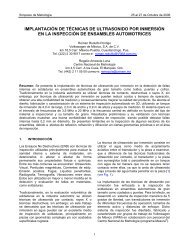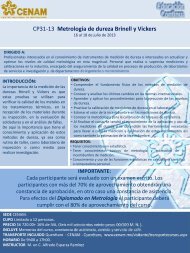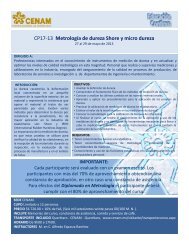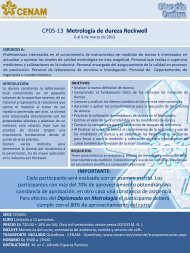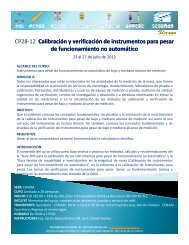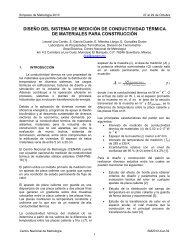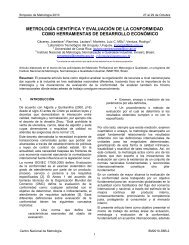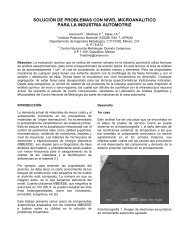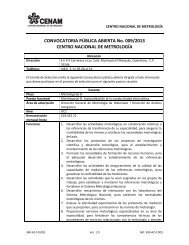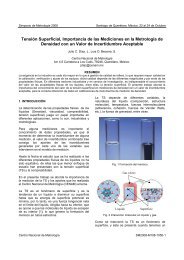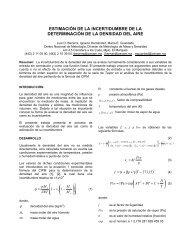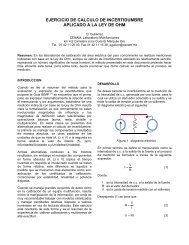la incertidumbre expandida y los grados de libertad - Centro ...
la incertidumbre expandida y los grados de libertad - Centro ...
la incertidumbre expandida y los grados de libertad - Centro ...
You also want an ePaper? Increase the reach of your titles
YUMPU automatically turns print PDFs into web optimized ePapers that Google loves.
Los valores <strong>de</strong> tp(ν) se encuentran en tab<strong>la</strong>s [1, 2].<br />
En el caso <strong>de</strong> <strong>la</strong> <strong>incertidumbre</strong> por repetibilidad, ν<br />
es el número <strong>de</strong> mediciones menos uno:<br />
ν = n −1<br />
(4)<br />
La ec. (3) refleja el hecho que <strong>la</strong> distribución <strong>de</strong> <strong>los</strong><br />
q , dividida entre s( q ), sigue una distribución t <strong>de</strong><br />
Stu<strong>de</strong>nt, que, en el caso <strong>de</strong> pocas mediciones<br />
difiere notablemente <strong>de</strong> una distribución normal.<br />
Por ejemplo, para obtener un nivel <strong>de</strong> confianza p =<br />
95,45% en el caso <strong>de</strong> sólo 3 mediciones, hay que<br />
expandir <strong>la</strong> <strong>incertidumbre</strong> estándar por un factor<br />
t95,45(2) = 4,53 en lugar <strong>de</strong> k = 2.<br />
INCERTIDUMBRE COMBINADA Y<br />
EXPANDIDA DE ACUERDO A LA GUM<br />
A <strong>la</strong> <strong>incertidumbre</strong> <strong>de</strong> un mensurando generalmente<br />
contribuye una serie <strong>de</strong> fuentes <strong>de</strong> <strong>incertidumbre</strong>,<br />
que se combinan según <strong>la</strong> ley <strong>de</strong> propagación <strong>de</strong><br />
<strong>incertidumbre</strong>s [1], obteniendo <strong>de</strong> esta manera <strong>la</strong><br />
<strong>incertidumbre</strong> combinada uc.<br />
En equivalencia a (3), <strong>la</strong> <strong>incertidumbre</strong> <strong>expandida</strong><br />
Up para un nivel <strong>de</strong> confianza p se estima por:<br />
U = t (ν ) ⋅u<br />
(5)<br />
p<br />
p<br />
ef<br />
c<br />
νef es el número efectivo <strong>de</strong> <strong>los</strong> <strong>grados</strong> <strong>de</strong> <strong>libertad</strong>,<br />
que se calcu<strong>la</strong> según <strong>la</strong> ecuación <strong>de</strong> Welch-<br />
Satterthwaite (ver p. ej. [1]):<br />
1<br />
ν<br />
ef<br />
⎛ u<br />
N<br />
i<br />
= ∑ ⎜<br />
i= 1 uc<br />
⎝<br />
⎞<br />
⎟<br />
⎠<br />
4<br />
1<br />
⋅<br />
ν<br />
i<br />
(6)<br />
don<strong>de</strong> ui es <strong>la</strong> <strong>la</strong> contribución <strong>de</strong> <strong>la</strong> fuente <strong>de</strong><br />
<strong>incertidumbre</strong> i al mensurando y νi son <strong>los</strong> <strong>grados</strong><br />
<strong>de</strong> <strong>libertad</strong> <strong>de</strong> <strong>la</strong> fuente i. Para <strong>incertidumbre</strong>s por<br />
repetibilidad o reproducibilidad, νi se obtiene <strong>de</strong><br />
acuerdo a (4). Para <strong>incertidumbre</strong>s obtenidas por un<br />
método tipo B <strong>la</strong> GUM menciona una reg<strong>la</strong> para<br />
asignarles un número <strong>de</strong> <strong>grados</strong> <strong>de</strong> <strong>libertad</strong>,<br />
ampliando el concepto <strong>de</strong> (2) (ver [1], G.4).<br />
Con el número efectivo <strong>de</strong> <strong>grados</strong> <strong>de</strong> <strong>libertad</strong> νef se<br />
<strong>de</strong>termina el factor tp(νef).<br />
PROBLEMÁTICA<br />
A diferencia <strong>de</strong> este método recomendado por <strong>la</strong><br />
GUM, en muchos <strong>la</strong>boratorios se aplican métodos<br />
que preten<strong>de</strong>n ser simplificados, evitando el cálculo<br />
<strong>de</strong> νef [3, 4, 5, 6]. El concepto común consiste en<br />
incrementar <strong>la</strong> <strong>incertidumbre</strong> obtenida por un<br />
método tipo A, por ejemplo <strong>la</strong> <strong>incertidumbre</strong> por<br />
repetibilidad, antes <strong>de</strong> <strong>la</strong> combinación:<br />
u = t ( n −1)<br />
⋅u<br />
(7)<br />
+<br />
A<br />
p<br />
A<br />
Después se calcu<strong>la</strong> <strong>la</strong> <strong>incertidumbre</strong> combinada uc<br />
+<br />
utilizando u A en lugar <strong>de</strong> uA y se se expan<strong>de</strong> uc<br />
con k = 2 en lugar <strong>de</strong> t95(νef) para aspirar un nivel <strong>de</strong><br />
confianza <strong>de</strong> 95%.<br />
Rigurosamente, <strong>de</strong> acuerdo a <strong>la</strong> GUM ([1], E.4.1),<br />
este procedimiento no es válido, <strong>de</strong>bido a que <strong>la</strong> ley<br />
<strong>de</strong> propagación <strong>de</strong> <strong>incertidumbre</strong>s sólo aplica para<br />
combinar <strong>incertidumbre</strong>s estándar, mientras u +<br />
A<br />
representa una <strong>incertidumbre</strong> <strong>expandida</strong>.<br />
A continuación se presenta una comparación<br />
numérica entre el método recomendado por <strong>la</strong> GUM<br />
y varios métodos simplificados.<br />
MÉTODOS ANALIZADOS Y PROCEDIMIENTO<br />
DE LA COMPARACIÓN NUMÉRICA<br />
En este análisis todos <strong>los</strong> métodos tienen como<br />
meta un nivel <strong>de</strong> confianza p = 95,45%.<br />
Para <strong>la</strong> comparación se consi<strong>de</strong>ran dos<br />
contribuciones a <strong>la</strong> <strong>incertidumbre</strong>: una contribución<br />
uA obtenida por un método <strong>de</strong> evaluación tipo A,<br />
por ejemplo repetibilidad, y una componente uB ,<br />
que es <strong>la</strong> combinación, en forma <strong>de</strong> una<br />
<strong>incertidumbre</strong> estándar, <strong>de</strong> todas <strong>la</strong>s <strong>de</strong>más<br />
contribuciones obtenidas por métodos tipo B. No se<br />
consi<strong>de</strong>ran corre<strong>la</strong>ciones, así que se obtiene <strong>la</strong><br />
<strong>incertidumbre</strong> combinada por:<br />
c<br />
2<br />
A<br />
2<br />
B<br />
u = u + u<br />
(8)<br />
A continuación se muestran <strong>los</strong> métodos<br />
analizados. El número en el subíndice indica su<br />
i<strong>de</strong>ntificación en <strong>la</strong>s gráficas presentadas. νA son <strong>los</strong><br />
<strong>grados</strong> <strong>de</strong> <strong>libertad</strong> asociados con uA .




